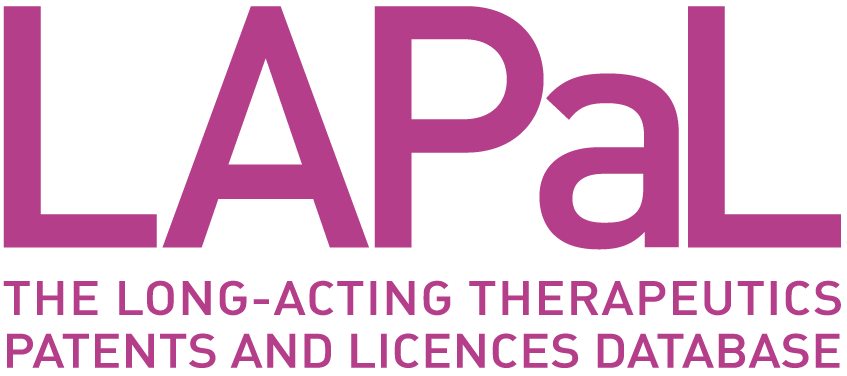
|
Developed by 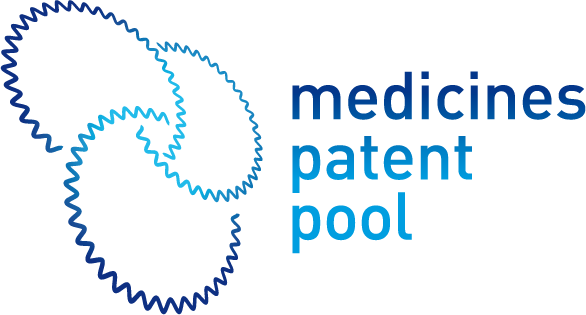

|
Supported by 

|
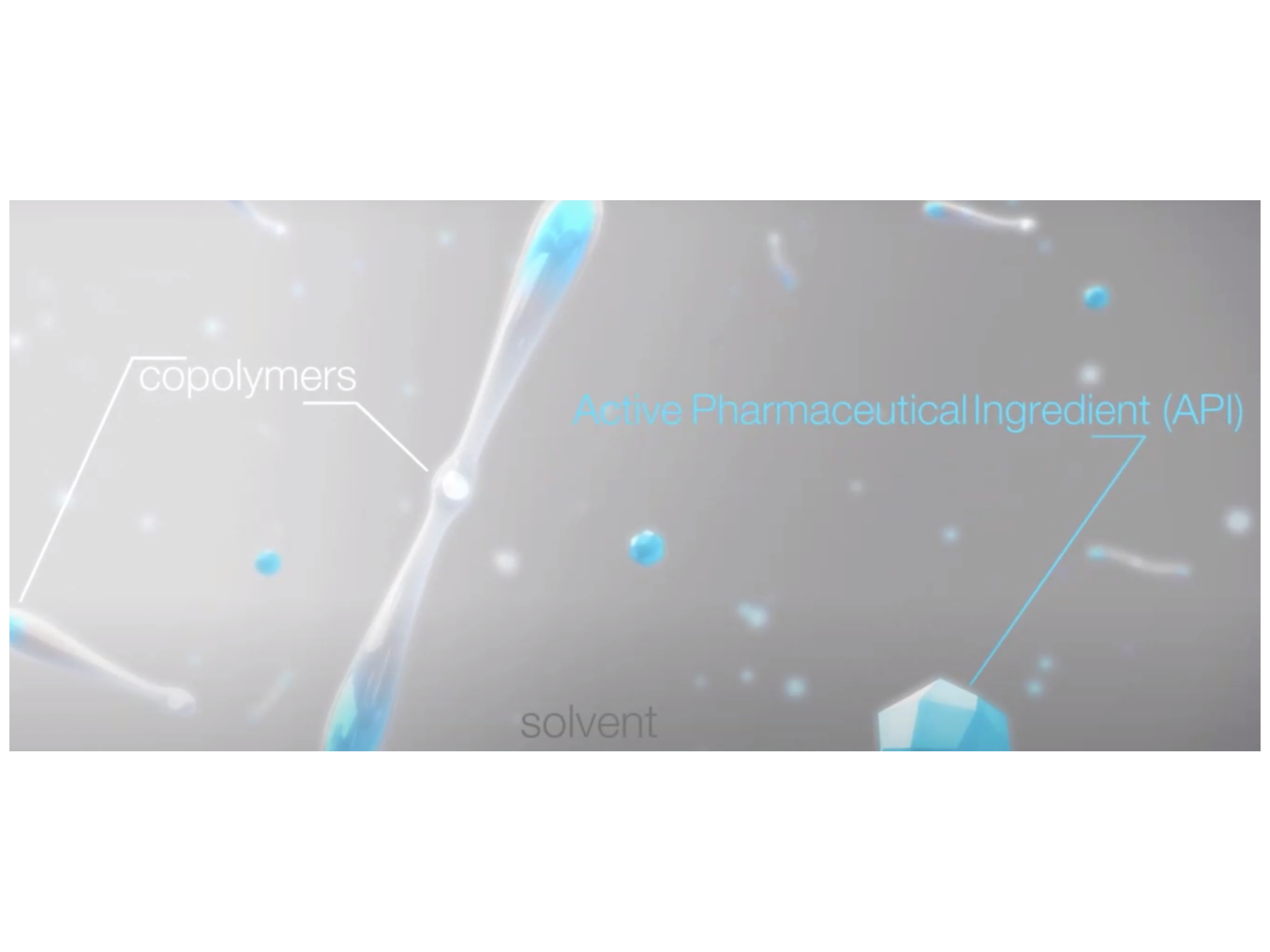
BEPO®
Based on public informationDeveloper(s)
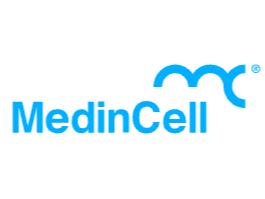
|
MEDINCELL Originator
www.medincell.com
France MedinCell® is a pharmaceutical company at premarketing stage that develops innovative long-acting injectable medicines in many therapeutic areas. Products of our portfolio are based on our BEPO® technology and aim to ensure patient compliance, improve the effectiveness and accessibility of treatments, and reduce their environmental footprint. |
Sponsor(s)
|
No sponsor indicated |
Partnerships

|
TEVA Pharmaceuticals www.tevapharm.com |

|
Arthritis Innovation Corporation (AIC) www.aic.com/about-us |

|
UNITAID www.unitaid.org |

|
The Bill and Melinda Gates Foundation www.gatesfoundation.org |
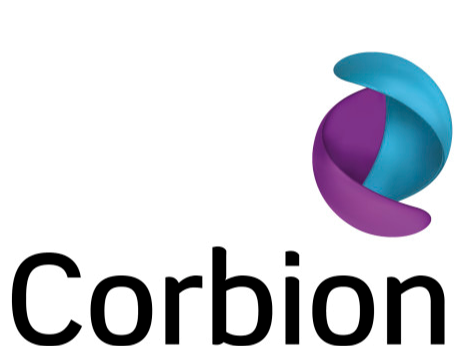
|
CORBION www.corbion.com |
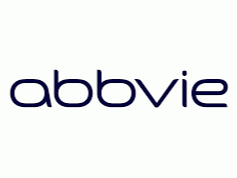
|
Abbvie https://www.abbvie.com/ |
Technology information
Type of technology
In-situ forming gel/implant
Administration route
Subcutaneous, Intra-articular
Development state and regulatory approval
Risperidone
Marketed
FDA approved (UZEDY)
Description
BEPO® is a simple yet flexible technology based on MedinCell®'s custom proprietary copolymers, which forms a fully bioresorbable depot once injected. BEPO® technology has the potential to control regular delivery of an API at an optimal therapeutic dose for several days, weeks or months. BEPO® can be administered subcutaneously for systemic exposure of APIs or locally for targeted treatments.
Technology highlight
From systemic to local delivery, BEPO® is a clinically advanced proprietary long acting injectable technology that enables the controlled delivery of various active ingredients, to address a broad range of therapeutic needs. BEPO® technology makes possible to control and guarantee the regular delivery of a drug at the optimal therapeutic dose for several days, weeks or months. At the time of the injection, the BEPO technology forms a deposit of polymers of a few millimeters under the skin for a systemic action, or locally for a targeted action. The deposit diffuses the active ingredient by resorbing for the desired duration, like a mini pump that would be injectable and bioresorbable.
Technology main components
Three core components: a- A combination of diblock (DB) and triblock (TB) copolymers containing hydrophilic and water-soluble blocks (polyethylene glycol – PEG) linked with hydrophobic and amorphous blocks (Poly(D,L-lactic acid) – PLA) which precipitate in forming a depot when exposed to an aqueous environment. They are functional excipients, ensuring the controlled drug release. b- A pharmaceutically acceptable organic solvent, e.g. DMSO, to dissolve the copolymers and make the entire system injectable. c- An API to ensure pharmacological activity. The API can be a small molecule, a peptide or a therapeutic protein. The API is entrapped within the polymer matrix and is released thereafter by diffusion and following polymer degradation.
Information on the raw materials sourcing, availability and anticipated price
The core functional copolymer excipients are exclusively manufactured and supplied through a joint Venture made between Medincell and Corbion, called CMB. Corbion manufactures the copolymers with the appropriate quality standards and scale to ensure sufficient availability.
Delivery device(s)
No delivery device
APIs compatibility profile
API desired features
Small molecules
Small molecules are best suited for formulating. Compatibility needs to be determined on a case-by-case basis.
Proteins
Case by case basis. Complex biomacromolecules like therapeutic proteins have inherent challenges that need to be tackled specifically during formulation development
Additional solubility data
Not provided
Additional stability data
Not provided
API loading: Maximum drug quantity to be loaded
0.1-60%
API co-administration
1 single API :
LogP
Min: -2.5 Max: 6.1
Scale-up and manufacturing prospects
Scale-up prospects
Not provided
Tentative equipment list for manufacturing
Not provided
Manufacturing
Not provided
Specific analytical instrument required for characterization of formulation
Not provided
Clinical trials
Celecoxib LA: Safety and Activity of F14 for Management of Pain Following Total Knee Replacement
Identifier
NCT03541655
Link
https://clinicaltrials.gov/study/NCT03541655
Phase
Phase II
Status
Completed
Sponsor
Arthritis Innovation Corporation
More details
The safety and activity of a single, 3.5 mL dose of F14 (celecoxib) concurrent with standard of care analgesia administered following total knee replacement will be compared to standard of care analgesia alone.
Purpose
Safety and Activity of F14 for Management of Pain Following Total Knee Replacement
Interventions
Intervention 1
Intervention 2
Countries
Sites / Institutions
Not provided
Trials dates
Anticipated Start Date
Not provided
Actual Start Date
2018-05-04
Anticipated Date of Last Follow-up
2020-07-08
Estimated Primary Completion Date
2018-05-30
Estimated Completion Date
2018-05-30
Actual Primary Completion Date
2019-06-20
Actual Completion Date
2020-03-30
Studied populations
Age Cohort
- Adults
- Older Adults
Genders
- All
Accepts pregnant individuals
No
Accepts lactating individuals
Unspecified
Accepts healthy individuals
Yes
Comments about the studied populations
Inclusion Criteria: * Male and/or female indicated for primary, unilateral TKR * Between 45-80 years of age inclusive at the time of signing the informed consent * Capable of giving signed informed consent and complying with requirements and restrictions listed in the informed consent form (ICF) and in this protocol * Body Mass Index (BMI) ≤ 40 kg/m² * Medically stable as determined by the Investigator based on pre-study medical history, physical examination, clinical laboratory tests, and 12-lead electrocardiogram (ECG) findings * Absence of fixed flexion deformity exceeding 15° * Absence of varus or valgus deformity exceeding 15° * Minimum pre-operative flexion arc of 100° * Absence of steroid, hyaluronic acid, platelet rich plasma, or any other type of therapeutic injection(s) in the i
Health status
Not provided
Study type
Interventional (clinical trial)
Enrollment
20
Allocation
Randomized
Intervention model
Parallel Assignment
Intervention model description
Not provided
Masking
Single blind masking
Masking description
Not provided
Frequency of administration
Not provided
Studied LA-formulation(s)
Studied route(s) of administration
Use case
Treatment
Key resources
Risperidone LA: Study to Evaluate TV-46000 as Maintenance Treatment in Adult and Adolescent Participants With Schizophrenia (RISE)
Identifier
NCT03503318
Link
https://clinicaltrials.gov/study/NCT03503318
Phase
Phase III
Status
Completed
Sponsor
Teva Branded Pharmaceutical Products R&D, Inc.
More details
A Multicenter, Randomized, Double-Blind, Placebo-Controlled Study to Evaluate the Efficacy, Safety, and Tolerability of Risperidone Extended-Release Injectable Suspension (TV-46000) for Subcutaneous Use as Maintenance Treatment in Adult and Adolescent Patients With Schizophrenia: The purpose of the study is to evaluate the efficacy, safety, and tolerability of different dose regimens of TV-46000 administered subcutaneously (SC) as compared to placebo during maintenance treatment in adult and adolescent participants with schizophrenia. The study will include male and female participants, 13 to 65 years of age, who have a confirmed diagnosis of schizophrenia, are clinically stable, and are eligible for risperidone treatment
Purpose
Study to Evaluate TV-46000 as Maintenance Treatment in Adult and Adolescent Participants With Schizophrenia
Interventions
Intervention 1
Intervention 2
Countries
Sites / Institutions
Not provided
Trials dates
Anticipated Start Date
Not provided
Actual Start Date
2018-04-27
Anticipated Date of Last Follow-up
2023-02-08
Estimated Primary Completion Date
2018-04-19
Estimated Completion Date
2018-04-19
Actual Primary Completion Date
2020-09-30
Actual Completion Date
2020-12-03
Studied populations
Age Cohort
- Adolescents
- Adults
- Older Adults
Genders
- All
Accepts pregnant individuals
Unspecified
Accepts lactating individuals
Unspecified
Accepts healthy individuals
No
Comments about the studied populations
Inclusion Criteria: * The participant has a diagnosis of schizophrenia for \>1 year and has had ≥1 episode of relapse in the last 24 months. * The participant has been responsive to an antipsychotic treatment (other than clozapine) in the past year based on discussions with family members or healthcare professionals. * The participant has a stable place of residence for the previous 3 months before screening, and changes in residence are not anticipated over the course of study participation. * The participant has no significant life events that could affect study outcomes expected throughout the period of study participation. * Women of childbearing potential and sexually-active female adolescents must agree not to try to become pregnant, and, unless they have exclusively same-sex partne
Health status
Not provided
Study type
Interventional (clinical trial)
Enrollment
544
Allocation
Randomized
Intervention model
Parallel Assignment
Intervention model description
Study protocol: https://cdn.clinicaltrials.gov/large-docs/18/NCT03503318/Prot_002.pdf
Masking
Quadruple-blind masking
Masking description
Not provided
Frequency of administration
Studied LA-formulation(s)
Studied route(s) of administration
Use case
Treatment
Key resources
Risperidone LA: SHINE: A Study to Test if TV-46000 is Safe for Maintenance Treatment of Schizophrenia
Identifier
NCT03893825
Link
https://clinicaltrials.gov/study/NCT03893825
Phase
Phase III
Status
Completed
Sponsor
Teva Branded Pharmaceutical Products R&D, Inc.
More details
The primary objective of the study is to evaluate the long-term safety and tolerability of TV-46000. The primary safety and tolerability endpoint is the frequency of all adverse events, including serious adverse events. For new participants, the total duration of participant participation in the study is planned to be up to 80 weeks (including a screening period of up to 4 weeks, a 12-week oral conversion/stabilization stage \[Stage 1\], a 56-week double-blind maintenance stage \[Stage 2\], and a follow-up period \[8 weeks\]). For roll-over participants, the total duration of participant participation in the study is planned to be up to 64 weeks (including up to 56 weeks in the maintenance stage \[Stage 2\] and a follow-up period \[8 weeks\]). Participants who started Stage 2 who relapse o
Purpose
A Study to Test if TV-46000 is Safe for Maintenance Treatment of Schizophrenia
Interventions
Intervention 1
Intervention 2
Countries
Sites / Institutions
Not provided
Trials dates
Anticipated Start Date
Not provided
Actual Start Date
2019-04-17
Anticipated Date of Last Follow-up
2022-12-05
Estimated Primary Completion Date
Not provided
Estimated Completion Date
Not provided
Actual Primary Completion Date
2021-12-02
Actual Completion Date
2021-12-02
Studied populations
Age Cohort
- Children
- Adults
- Older Adults
Genders
- All
Accepts pregnant individuals
Unspecified
Accepts lactating individuals
Unspecified
Accepts healthy individuals
No
Comments about the studied populations
Inclusion Criteria: Participants Rolling Over from the Pivotal Efficacy Study TV46000-CNS-30072: * The participant must have participated in the pivotal efficacy study (Study TV46000-CNS-30072) without experiencing relapse events and without important protocol deviations. * If the participant was taking antidepressants or mood stabilizers in Study TV46000-CNS-30072, no dose changes or initiation of treatment with these medications will be permitted. * The participant, in the investigator's judgment, requires chronic treatment with an antipsychotic medication. * The participant is able to understand the nature of the study and follow protocol requirements, including the prescribed dosage regimens (oral and SC administration) and non-use of prohibited concomitant medications; can read and
Health status
Not provided
Study type
Interventional (clinical trial)
Enrollment
336
Allocation
Randomized
Intervention model
Parallel Assignment
Intervention model description
Not provided
Masking
Quadruple-blind masking
Masking description
Not provided
Frequency of administration
Not provided
Studied LA-formulation(s)
Studied route(s) of administration
Use case
Treatment
Key resources
Celecoxib LA: Safety of F14 Following Total Knee Replacement (100-CIP03-P)
Identifier
NCT04860635
Link
https://clinicaltrials.gov/study/NCT04860635
Phase
Phase II/III
Status
Suspended
Sponsor
Arthritis Innovation Corporation
More details
Study superseded by alternative Phase 3 trial Open-label single-arm study in which all subjects receive F14 as part of a scheduled TKR and multimodal analgesia
Purpose
Safety of F14 Following Total Knee Replacement
Interventions
Intervention 1
Countries
Sites / Institutions
Not provided
Trials dates
Anticipated Start Date
2025-08-01
Actual Start Date
Not provided
Anticipated Date of Last Follow-up
2025-02-04
Estimated Primary Completion Date
2027-01-01
Estimated Completion Date
2027-01-01
Actual Primary Completion Date
Not provided
Actual Completion Date
Not provided
Studied populations
Age Cohort
- Adults
- Older Adults
Genders
- All
Accepts pregnant individuals
No
Accepts lactating individuals
Unspecified
Accepts healthy individuals
No
Comments about the studied populations
Inclusion Criteria: 1. Male and/or females indicated for primary, unilateral TKR 2. Between 45-80 years of age 3. Capable of giving signed informed consent 4. Body Mass Index (BMI) ≤ 40 kg/m2 5. Medically stable as determined by the Investigator, based on physical examination, clinical laboratory tests, and 12-lead ECG findings, as well as medical history from subject and pre-study source documents from other care providers 6. Absence of fixed flexion deformity exceeding 15deg 7. Absence of varus or valgus deformity exceeding 15deg 8. Minimum pre-operative flexion arc of 100deg 9. American Society of Anesthesiologists Physical Status Classification System (ASA-PSC) score ≤ 3 10. Females of childbearing potential with a negative serum pregnancy test at screening or males with a partner tha
Health status
Not provided
Study type
Interventional (clinical trial)
Enrollment
100
Allocation
Non-randomized
Intervention model
Single group assignment
Intervention model description
Not provided
Masking
Open label
Masking description
Not provided
Frequency of administration
Not provided
Studied LA-formulation(s)
Studied route(s) of administration
Use case
Treatment
Key resources
A Celecoxib LA: Phase 3 Study of F14 for Management of Pain Following Total Knee Replacement (100-CIP02-P)
Identifier
NCT05603832
Link
https://clinicaltrials.gov/study/NCT05603832
Phase
Phase III
Status
Completed
Sponsor
Arthritis Innovation Corporation
More details
This is a Phase 3, randomized, double blind, multicenter study to evaluate the analgesic efficacy and safety of a single intra-articular dose of F14 (625 mg sustained release celecoxib) administered concurrent with multimodal analgesia in patients undergoing total knee replacement surgery, compared to multimodal analgesia alone.
Purpose
A Phase 3 Study of F14 for Management of Pain Following Total Knee Replacement
Interventions
Intervention 1
Intervention 2
Intervention 3
Intervention 4
Countries
Sites / Institutions
Not provided
Trials dates
Anticipated Start Date
Not provided
Actual Start Date
2022-11-17
Anticipated Date of Last Follow-up
2024-01-29
Estimated Primary Completion Date
Not provided
Estimated Completion Date
2024-08-01
Actual Primary Completion Date
2023-11-22
Actual Completion Date
Not provided
Studied populations
Age Cohort
- Adults
- Older Adults
Genders
- All
Accepts pregnant individuals
No
Accepts lactating individuals
Unspecified
Accepts healthy individuals
No
Comments about the studied populations
Inclusion Criteria: * Male and/or females indicated for primary, unilateral total knee replacement (TKR) * Between 45-80 years of age inclusive at the time of signing the informed consent * Capable of giving signed informed consent and complying with requirements and restrictions listed in the informed consent form (ICF) and in this protocol * Body Mass Index (BMI) ≤ 40 kg/m2 * Medically stable as determined by the Investigator, based on physical examination, clinical laboratory tests, and 12-lead electrocardiogram (ECG) findings, as well as medical history from patient and pre-study source documents from other care providers * Absence of moderate to severe fixed flexion deformity * Absence of moderate to severe varus or valgus deformity * Minimum pre-operative flexion arc of 100 degrees
Health status
Not provided
Study type
Interventional (clinical trial)
Enrollment
151
Allocation
Randomized
Intervention model
Parallel Assignment
Intervention model description
Not provided
Masking
Double-blind masking
Masking description
Not provided
Frequency of administration
Not provided
Studied LA-formulation(s)
Studied route(s) of administration
Not provided
Use case
Treatment
Key resources
Olanzapine Prolonged-Release Suspension for Subcutaneous Administration A 21-Week, Multicenter, Open-Label, Multiple-Dose Trial to Assess the Comparative BioavailabilityTV44749-BA-10196
Identifier
NCT06315283
Link
https://clinicaltrials.gov/study/NCT06315283
Phase
Phase I
Status
Recruiting
Sponsor
Teva Branded Pharmaceutical Products R&D, Inc.
More details
The primary objective of the study is to evaluate the comparative bioavailability of TV-44749 administered subcutaneous (sc) to oral olanzapine (ZYPREXA®) at steady state in participants with schizophrenia. A secondary objective of this trial is to evaluate the safety and tolerability of multiple doses of TV-44749 administered sc in participants with schizophrenia. Another secondary objective of this trial is to compare additional pharmacokinetic parameters of TV-44749 administered sc with oral olanzapine (ZYPREXA®) at steady state in participants with schizophrenia. The total duration of participation in the trial for each participant is planned to be approximately 21 weeks.
Purpose
An Open-Label Trial to Assess the Comparative Bioavailability of TV-44749 to Oral Olanzapine in Participants With Schizophrenia
Interventions
Intervention 1
Intervention 2
Countries
Sites / Institutions
Not provided
Trials dates
Anticipated Start Date
Not provided
Actual Start Date
2024-03-20
Anticipated Date of Last Follow-up
2024-07-24
Estimated Primary Completion Date
2025-04-18
Estimated Completion Date
2025-04-18
Actual Primary Completion Date
Not provided
Actual Completion Date
Not provided
Studied populations
Age Cohort
- Adults
Genders
- All
Accepts pregnant individuals
No
Accepts lactating individuals
No
Accepts healthy individuals
No
Comments about the studied populations
Inclusion Criteria: * Agree to maintain current smoking or nonsmoking status at the time informed consent is obtained and throughout the trial until completion of the EOT or ET visit (ie, nonsmoking participants must agree not to start smoking and participants who smoke will be excluded if they plan to discontinue smoking during the trial period). * Have a current confirmed diagnosis of schizophrenia according to an evaluation by the Investigator, as defined by the DSM-5 (American Psychiatric Association 2013a). * Are clinically stable on oral olanzapine 20 mg daily (ie, dose has not changed in the last 4 weeks) and not currently on other antipsychotic treatments at the time of screening. Participants on alternative olanzapine regimens (eg, 10 mg twice daily) may be considered for inclusi
Health status
Not provided
Study type
Interventional (clinical trial)
Enrollment
116
Allocation
Non-randomized
Intervention model
Cross-over assignment
Intervention model description
Not provided
Masking
Open label
Masking description
Not provided
Frequency of administration
Not provided
Studied LA-formulation(s)
Studied route(s) of administration
Use case
Treatment
Key resources
Olanzapine extended-release suspension for subcutaneous injection (TV-44749) and Zyprexa in Chinese patients with schizophrenia: Safety, tolerability and pharmacokinetic studies in patients with schizophrenia
Identifier
CTR20233083
Link
http://www.chinadrugtrials.org.cn/
Phase
Phase I
Status
Recruiting
Sponsor
Teva/Pliva
More details
Not provided
Purpose
To evaluate the safety, tolerability and pharmacokinetics of single-dose olanzapine extended-release suspension for subcutaneous injection (TV-44749) and Zyprexa in Chinese patients with schizophreni
Interventions
Intervention 1
Intervention 2
Countries
Sites / Institutions
Not provided
Trials dates
Anticipated Start Date
Not provided
Actual Start Date
2024-03-28
Anticipated Date of Last Follow-up
Not provided
Estimated Primary Completion Date
Not provided
Estimated Completion Date
2025-03-28
Actual Primary Completion Date
Not provided
Actual Completion Date
Not provided
Studied populations
Age Cohort
- Adults
Genders
- Male
- Female
Accepts pregnant individuals
No
Accepts lactating individuals
No
Accepts healthy individuals
No
Comments about the studied populations
Not provided
Health status
Not provided
Study type
Interventional (clinical trial)
Enrollment
36
Allocation
Non-randomized
Intervention model
Parallel Assignment
Intervention model description
Not provided
Masking
Open label
Masking description
Not provided
Frequency of administration
Studied LA-formulation(s)
Studied route(s) of administration
Use case
Treatment
Key resources
Olanzapine:SOLARIS: A Randomized, Double-Blind, Placebo-Controlled Study With an Open-Label, Long-Term Safety Phase to Evaluate the Efficacy and Safety of TV-44749 in Adults With Schizophrenia
Identifier
NCT05693935
Link
https://clinicaltrials.gov/study/NCT05693935
Phase
Phase III
Status
Completed
Sponsor
Teva Branded Pharmaceutical Products R&D, Inc.
More details
The primary objective of this study is to evaluate the efficacy of TV-44749 in adult participants with schizophrenia. A key secondary objective is to further evaluate the efficacy of TV-44749 based on additional parameters in adult participants with schizophrenia. A secondary objective is to evaluate the safety and tolerability of TV-44749 in adult participants with schizophrenia Another secondary objective of this study is to evaluate the efficacy of TV-44749 from baseline to endpoint in Period 1 in adult participants with schizophrenia. Total study duration is up to 61 weeks, and treatment duration is up to 56 weeks, with weekly visits during the first 8 weeks and then monthly in-clinic visits with weekly calls during the remainder of the treatment period.
Purpose
A Randomized, Double-Blind, Placebo-Controlled Study With an Open-Label, Long-Term Safety Phase to Evaluate the Efficacy and Safety of TV-44749 in Adults With Schizophrenia
Interventions
Intervention 1 Potential application(s)
Countries
Sites / Institutions
Not provided
Trials dates
Anticipated Start Date
Not provided
Actual Start Date
2023-01-24
Anticipated Date of Last Follow-up
2025-06-05
Estimated Primary Completion Date
Not provided
Estimated Completion Date
2025-01-13
Actual Primary Completion Date
2024-03-19
Actual Completion Date
2025-01-27
Studied populations
Age Cohort
- Adults
Genders
- All
Accepts pregnant individuals
Unspecified
Accepts lactating individuals
Unspecified
Accepts healthy individuals
No
Comments about the studied populations
Inclusion Criteria: * The participant has a current confirmed diagnosis of schizophrenia according to the DSM-5, for \>1 year * The participant has exacerbation of schizophrenia that started ≤8 weeks prior to screening and would benefit from psychiatric hospitalization or continued hospitalization for symptoms of schizophrenia. * Participants who have received an antipsychotic treatment (other than clozapine) in the past year must have been responsive based on the investigator's judgment (and based on discussions with family members, caregivers, or healthcare professionals, as applicable). * Body mass index between 18.0 and 40.0 kg/m2, inclusive, at the time of screening * Women may be included only if they have a negative beta-human chorionic gonadotropin (β-HCG) test at screening and ba
Health status
Not provided
Study type
Interventional (clinical trial)
Enrollment
675
Allocation
Randomized
Intervention model
Parallel Assignment
Intervention model description
Not provided
Masking
Quadruple-blind masking
Masking description
Not provided
Frequency of administration
Not provided
Studied LA-formulation(s)
Studied route(s) of administration
Not provided
Use case
Treatment
Key resources
Olanzapine: TV44749-PK-10188 : Safety, Tolerability, and Pharmacokinetic Study of TV-44749 in Chinese Patients With Schizophrenia
Identifier
NCT06253546
Link
https://clinicaltrials.gov/study/NCT06253546
Phase
Phase I
Status
Completed
Sponsor
Teva Branded Pharmaceutical Products R&D, Inc.
More details
Primary Objective: To evaluate the safety and tolerability of single doses of TV-44749 for subcutaneous (sc) use in Chinese participants with schizophrenia. Secondary Objectives: * To evaluate the pharmacokinetics (PK) of single doses of TV-44749 administered sc. * To evaluate the pharmacokinetics of oral olanzapine tablets following multiple dose administration. * To monitor the safety and tolerability of multiple doses of oral olanzapine tablets given in the study.
Purpose
Safety, Tolerability, and Pharmacokinetic Study of TV-44749 in Chinese Patients With Schizophrenia
Interventions
Intervention 1
Intervention 2
Countries
Sites / Institutions
Not provided
Trials dates
Anticipated Start Date
Not provided
Actual Start Date
2024-03-28
Anticipated Date of Last Follow-up
2025-07-31
Estimated Primary Completion Date
2025-06-10
Estimated Completion Date
2025-06-10
Actual Primary Completion Date
2025-06-12
Actual Completion Date
2025-06-12
Studied populations
Age Cohort
- Adults
Genders
- All
Accepts pregnant individuals
Unspecified
Accepts lactating individuals
Unspecified
Accepts healthy individuals
No
Comments about the studied populations
Inclusion Criteria: * Body weight \>50 kg and body mass index (BMI) between 18.5 to 38.0 kg/m2, inclusive, at the time of screening. * A current confirmed diagnosis of schizophrenia according to an evaluation by the investigator, using the Diagnostic and Statistical Manual of Mental Disorders, Fifth Edition (DSM-5) * Are clinically stable, on oral olanzapine (i.e., dose has not changed in the last 4 weeks), and not currently on other antipsychotic treatment at the time of screening. * No hospitalization for worsening of schizophrenic symptoms and no significant exacerbation of schizophrenic symptoms, as judged by the investigator, within the 3 months prior to screening. * Female participants must have a negative serum pregnancy test at screening, are sterile or postmenopausal, and not pla
Health status
Not provided
Study type
Interventional (clinical trial)
Enrollment
24
Allocation
Not provided
Intervention model
Parallel Assignment
Intervention model description
Not provided
Masking
Open label
Masking description
Not provided
Frequency of administration
Not provided
Studied LA-formulation(s)
Studied route(s) of administration
Not provided
Use case
Treatment
Key resources
Olanzapine: TV44749-NPC-10205
Identifier
NCT06319170
Link
https://clinicaltrials.gov/study/NCT06319170
Phase
Phase I
Status
Completed
Sponsor
Teva Branded Pharmaceutical Products R&D, Inc.
More details
The primary objective of the study is to characterize the pharmacokinetics of 3 formulations of olanzapine. A secondary objective is to evaluate the safety and tolerability of 3 formulations of olanzapine. Another secondary objective is to characterize the pharmacokinetics of ZYPREXA. The planned duration of the study for each participant is 19 weeks.
Purpose
Open-label Trial Characterizing the PK of 3 SC Olanzapine Extended-release Formulations in Participants With Schizophrenia/Schizoaffective Disorder
Interventions
Intervention 1
Intervention 2
Countries
Sites / Institutions
Not provided
Trials dates
Anticipated Start Date
Not provided
Actual Start Date
2024-03-28
Anticipated Date of Last Follow-up
2025-03-04
Estimated Primary Completion Date
2024-12-11
Estimated Completion Date
2024-12-11
Actual Primary Completion Date
2025-01-15
Actual Completion Date
2025-01-15
Studied populations
Age Cohort
- Adults
Genders
- All
Accepts pregnant individuals
Unspecified
Accepts lactating individuals
Unspecified
Accepts healthy individuals
No
Comments about the studied populations
Inclusion Criteria: * Body weight \>50 kg and body mass index (BMI) within the range 18.5 to 38.0 kg/m2, inclusive, at the time of screening * Agree to maintain current smoking or nonsmoking status at the time informed consent is obtained and throughout the trial until completion of the end of treatment or early termination (ET) visit (ie, nonsmoking participants must agree not to start smoking and participants who smoke will be excluded if they plan to discontinue smoking during the trial * Agree to the inpatient periods required during the trial period * Have a current confirmed diagnosis of schizophrenia or schizoaffective disorder according to an evaluation by the Investigator, using the Diagnostic and Statistical Manual of Mental Disorders, Fifth Edition (DSM-5) (American Psychiatric
Health status
Not provided
Study type
Interventional (clinical trial)
Enrollment
91
Allocation
Randomized
Intervention model
Parallel Assignment
Intervention model description
Not provided
Masking
Open label
Masking description
Not provided
Frequency of administration
Not provided
Studied LA-formulation(s)
Studied route(s) of administration
Not provided
Use case
Treatment
Key resources
mdc-TTG-CT-001
Identifier
NCT04632706
Link
https://clinicaltrials.gov/study/NCT04632706
Phase
Phase I
Status
Completed
Sponsor
MedinCell S.A
More details
An early stage trial to check how safe and tolerable, as well as how the body handles continuous daily use of Active IMP over 28 days in healthy volunteers.
Purpose
Exploratory Ph I Trial of the Active IMP in Healthy Volunteers in Relation to COVID-19
Interventions
Intervention 1
Intervention 2
Countries
Sites / Institutions
Not provided
Trials dates
Anticipated Start Date
Not provided
Actual Start Date
2020-09-22
Anticipated Date of Last Follow-up
2021-12-22
Estimated Primary Completion Date
Not provided
Estimated Completion Date
Not provided
Actual Primary Completion Date
2021-03-09
Actual Completion Date
2021-03-09
Studied populations
Age Cohort
- Adults
Genders
- Male
Accepts pregnant individuals
Unspecified
Accepts lactating individuals
Unspecified
Accepts healthy individuals
Yes
Comments about the studied populations
Important Inclusion Criteria: * Subject is male of any ethnic origin. * Subject is aged between 18 to 45 years, inclusive. * Subject has a body mass index (BMI) of 18.5 to 32.0 kg/m2, inclusive. * Subject is ≥50 kg. * Negative reverse transcription polymerase chain reaction (RT-PCR) Test for severe acute respiratory syndrome coronavirus-2 (SARS-CoV-2) at Screening and negative lateral flow immunoassay test for SARS-CoV-2 at Day -1. * Healthy as determined by a responsible physician, based on medical evaluation including medical history, physical examinations, neurological examinations, concomitant medication, vital signs, 12-lead ECG and clinical laboratory evaluations. * Male subjects must use a condom during the study and for 3 months after their final dose of study medication, if their
Health status
Not provided
Study type
Interventional (clinical trial)
Enrollment
24
Allocation
Randomized
Intervention model
Sequential assignment
Intervention model description
Not provided
Masking
Double-blind masking
Masking description
Not provided
Frequency of administration
Not provided
Studied LA-formulation(s)
Studied route(s) of administration
Use case
Prevention
Key resources
SAIVE
Identifier
NCT05305560
Link
https://clinicaltrials.gov/study/NCT05305560
Phase
Phase II
Status
Completed
Sponsor
MedinCell S.A
More details
A multicenter, randomized, double-blind, placebo-controlled, study to evaluate the efficacy and safety of oral ivermectin tablets versus placebo for COVID-19 prophylaxis
Purpose
A Study to Evaluate the Efficacy and Safety of Ivermectin in COVID-19 Prevention
Interventions
Intervention 1
Intervention 2
Countries
Sites / Institutions
Not provided
Trials dates
Anticipated Start Date
Not provided
Actual Start Date
2022-03-25
Anticipated Date of Last Follow-up
2024-12-10
Estimated Primary Completion Date
Not provided
Estimated Completion Date
Not provided
Actual Primary Completion Date
2022-09-15
Actual Completion Date
2022-10-13
Studied populations
Age Cohort
- Adults
- Older Adults
Genders
- All
Accepts pregnant individuals
Unspecified
Accepts lactating individuals
Unspecified
Accepts healthy individuals
No
Comments about the studied populations
Inclusion Criteria: 1. Age between 18 and 65 years, inclusive. 2. Body weight \>45 kg. 3. Body Mass Index \>18.5. 4. Close contact with a person who has a PCR-confirmed SARS-CoV-2 infection within 5 days before screening. 5. Only one member in the same household will be enrolled. 6. Participants must be able to give informed consent and comply with the study's scheduled events/visits and study assessments. 7. SARS-CoV-2 positive index case must be able to give consent to enable collection of the documented positive PCR test. 8. Female participants of childbearing potential must use a highly effective method of contraception for the duration of the trial. Exclusion Criteria: 1. Pregnant or breast-feeding. 2. Participants who have been administered COVID-19 vaccine prior to the inclusion
Health status
Not provided
Study type
Interventional (clinical trial)
Enrollment
400
Allocation
Randomized
Intervention model
Parallel Assignment
Intervention model description
Not provided
Masking
Double-blind masking
Masking description
Not provided
Frequency of administration
Studied LA-formulation(s)
Studied route(s) of administration
Use case
Prevention
Key resources
Excipients
Proprietary excipients used
No proprietary excipient used
Novel excipients or existing excipients at a concentration above Inactive Ingredients Database (IID) for the specified route of administration
Confidential information
Residual solvents used
No residual solvent used
Additional features
Other features of the technology
- Biodegradable
- Room temperature storage
- At least 1 year shelf life
- Drug-eluting
- Non-removable
- Single-use
Release properties
BEPO® technology has the potential to control regular delivery of an API at an optimal therapeutic dose for several days, weeks or months. The technology can provide a sustained release profile of an API with low initial burst. The hygroscopy and consequently the API release kinetics from the depots can be fine-tuned by adjusting the hydrophilicity of the DB and TB and their relative ratio.
Injectability
BEPO® drug products are liquid and can be injected using standard injection device with standard 21 gauge needle or even thinner depending on the formulation characteristics.
Safety
We currently have 3 clinically advanced drug products based on BEPO® technology, including one at NDA stage with TEVA pharmaceuticals. The RISE clinical phase III study completed in November 2020 did not raise any safety signals that were inconsistent with the known safety profile of other risperidone formulations.
Stability
Our technology may allow long-term storage at room temperature with shelf life well above 1 year.
Storage conditions and cold-chain related features
Room Temperature storage possible. Cold chain is not mandatory, except in instances where the drug substance requires refrigeration for long term storage.
Potential application(s)
Therapeutic area(s)
Use case(s)
Use of technology
Ease of administration
- To be determined
- Administered by a nurse
- Administered by a specialty health worker
Frequency of administration
Depending on product, once weekly up to once annually, Weekly, Monthly, Every 6 months, Yearly, Every 2 months
User acceptance
Not provided
Targeted user groups
Age Cohort- Adults
- Older Adults
- All
- Male
- Female
- Cisgender female
- Cisgender male
- Transgender female
- Transgender male
- Intersex
- Gender non-binary
Pregnant individuals
Unspecified
Lactating individuals
Unspecified
Healthy individuals
Unspecified
Comment
Not provided
Potential associated API(s)
Risperidone
Class(es)
antipsychotic
Development stage
Marketed
Clinical trial number(s)
Not provided
Foreseen/approved indication(s)
Schizophrenia
Foreseen user group
UZEDY (risperidone) extended-release injectable suspension is a prescription medicine used to treat schizophrenia in adults.
Foreseen duration between application(s)
1 or 2 months
Applications to Stringent Regulatory Authorities (SRA) / regulatory approvals
FDA approved (UZEDY)
Celecoxib
Class(es)
anti inflammatory
Development stage
Phase III
Clinical trial number(s)
NCT05603832
Foreseen/approved indication(s)
post-operative pain and inflammation
Foreseen user group
Not provided
Foreseen duration between application(s)
Once every 12 weeks
Applications to Stringent Regulatory Authorities (SRA) / regulatory approvals
Not provided
Ivermectin
Class(es)
Not provided
Development stage
Pre-clinical
Clinical trial number(s)
Not provided
Foreseen/approved indication(s)
Malaria Transmission prevention
Foreseen user group
persons at risk of malaria and their communities
Foreseen duration between application(s)
Single intervention per year (3 months action duration)
Applications to Stringent Regulatory Authorities (SRA) / regulatory approvals
Not provided
Progestin
Class(es)
Not provided
Development stage
Pre-clinical
Clinical trial number(s)
Not provided
Foreseen/approved indication(s)
contraception
Foreseen user group
persons desiring contraception use
Foreseen duration between application(s)
6 months
Applications to Stringent Regulatory Authorities (SRA) / regulatory approvals
Not provided
Olanzapine
Class(es)
Not provided
Development stage
Phase III
Clinical trial number(s)
NCT05693935
Foreseen/approved indication(s)
schizophrenia management
Foreseen user group
Adults with schizophrenia
Foreseen duration between application(s)
1 month
Applications to Stringent Regulatory Authorities (SRA) / regulatory approvals
Not yet approved
Macozinone
Class(es)
antimycobacterial
Development stage
Pre-clinical
Clinical trial number(s)
Not provided
Foreseen/approved indication(s)
Not provided
Foreseen user group
Not provided
Foreseen duration between application(s)
Not provided
Applications to Stringent Regulatory Authorities (SRA) / regulatory approvals
Not provided
Progestin
Class(es)
contraceptive
Development stage
Pre-clinical
Clinical trial number(s)
Not provided
Foreseen/approved indication(s)
Not provided
Foreseen user group
Not provided
Foreseen duration between application(s)
6 months
Applications to Stringent Regulatory Authorities (SRA) / regulatory approvals
Not provided
Patent info
Technology patent families
Patent informations
| Patent description | Representative patent | Categories | Patent holder | Licence with MPP | Patent source |
|---|---|---|---|---|---|
|
Method for morselizing and/or targeting pharmaceutically active principles to synovial tissue
Expiry date: 2036-11-16 A method of targeting to the synovial tissue biodegradable drug delivery compositions or morselizing biodegradable drug delivery compositions are described. The biodegradable drug composition comprises a triblock copolymer containing a polyester and a polyethylene glycol and a diblock copolymer containing a polyester and an end-capped polyethylene glycol, as well as at least one pharmaceutically active principle is disclosed. |
WO2017085561 | Process | Medincell | Yes | MPP search |
Patent status
| Patent status/countries | Low, Low- middle and upper-middle | High income |
|---|---|---|
| Granted | China, Albania, Serbia, Türkiye, North Macedonia, India | Australia, Canada, Liechtenstein, Italy, Norway, Malta, Denmark, Belgium, United Kingdom, Greece, Netherlands, Hungary, Croatia, Switzerland, Spain, San Marino, Slovenia, Austria, Romania, Iceland, Cyprus, Finland, France, Bulgaria, Slovakia, Poland, Latvia, Ireland, Estonia, Germany, Luxembourg, Portugal, Czechia, Lithuania, Monaco, Sweden, Japan, Korea, Republic of, United States of America |
| Filed | Albania, Serbia, Türkiye, North Macedonia | Liechtenstein, Italy, Norway, Malta, Denmark, Belgium, United Kingdom, Greece, Netherlands, Hungary, Croatia, Switzerland, Spain, San Marino, Slovenia, Austria, Romania, Iceland, Cyprus, Finland, France, Bulgaria, Slovakia, Poland, Latvia, Ireland, Estonia, Germany, Luxembourg, Portugal, Czechia, Lithuania, Monaco, Sweden, United States of America |
| Not in force | World Intellectual Property Organization (WIPO), Morocco, Bosnia and Herzegovina, Montenegro, Moldova, Republic of | World Intellectual Property Organization (WIPO), United States of America |
MPP Licence(s)
MPP/MedinCell licence on a long-acting formulation of ivermectin developed using BEPO® technology
https://medicinespatentpool.org/licence-post/long-acting-technology-for-malaria-vector-controlPatent informations
| Patent description | Representative patent | Categories | Patent holder | Licence with MPP | Patent source |
|---|---|---|---|---|---|
|
Biodegradable drug delivery composition comprising triblock polymer and diblock polymer
Expiry date: 2033-06-27 A biodegradable drug delivery compositions comprising a triblock copolymer containing a polyester and a polyethylene glycol and a diblock copolymer containing a polyester and an end-capped polyethylene glycol, as well as at least one pharmaceutically active principle or hydrophobic active principle such as medroxyprogesterone acetate, levonorgestrel, cyclosporine, progesterone or bupivacaine is disclosed. |
WO2014001904 | Composition | Medincell | Yes | MPP licence |
Patent status
| Patent status/countries | Low, Low- middle and upper-middle | High income |
|---|---|---|
| Granted | Brazil, China, Kazakhstan, Montenegro, India, Mexico, Tunisia, Ukraine, South Africa, Indonesia, Malaysia, Viet Nam | Australia, Canada, Chile, Russian Federation, Liechtenstein, Italy, United Kingdom, Hungary, Switzerland, Spain, Cyprus, France, Germany, Hong Kong, Israel, Japan, Korea, Republic of, Singapore, Brunei Darussalam |
| Filed | Algeria, Nigeria | United Arab Emirates, Qatar |
| Not in force | World Intellectual Property Organization (WIPO), Colombia, Cuba, Tajikistan, Belarus, Azerbaijan, Turkmenistan, Armenia, Kyrgyzstan, Albania, Serbia, Bosnia and Herzegovina, Türkiye, North Macedonia, Morocco, Egypt, Thailand | World Intellectual Property Organization (WIPO), Costa Rica, Norway, Malta, Denmark, Belgium, Greece, Netherlands, Croatia, San Marino, Slovenia, Austria, Romania, Iceland, Finland, Bulgaria, Slovakia, Poland, Latvia, Ireland, Estonia, Luxembourg, Portugal, Czechia, Lithuania, Monaco, Sweden, United States of America, New Zealand |
MPP Licence(s)
MPP/MedinCell licence on a long-acting formulation of ivermectin developed using BEPO® technology
https://medicinespatentpool.org/licence-post/long-acting-technology-for-malaria-vector-controlPatent informations
| Patent description | Representative patent | Categories | Patent holder | Licence with MPP | Patent source |
|---|---|---|---|---|---|
|
Biodegradable drug delivery composition covering BEPO® technology
Expiry date: 2031-12-29 A biodegradable drug delivery compositions comprising a triblock copolymer containing a polyester and a polyethylene glycol and a diblock copolymer containing a polyester and an end-capped polyethylene glycol, as well as a pharmaceutically active principle is disclosed. |
WO2012090070 | Composition | Medincell | Yes | MPP licence |
Patent status
| Patent status/countries | Low, Low- middle and upper-middle | High income |
|---|---|---|
| Granted | Brazil, China, Kazakhstan, Türkiye, Mexico, Malaysia, Ukraine, South Africa, India, Indonesia, Viet Nam | Australia, Canada, Chile, Russian Federation, Liechtenstein, Italy, Norway, Denmark, Belgium, United Kingdom, Greece, Netherlands, Hungary, Croatia, Switzerland, Spain, Slovenia, Austria, Romania, Iceland, Cyprus, Finland, France, Bulgaria, Slovakia, Poland, Latvia, Ireland, Estonia, Germany, Luxembourg, Portugal, Czechia, Lithuania, Sweden, Israel, Japan, Korea, Republic of, New Zealand, Singapore, United States of America, Hong Kong |
| Filed | Thailand | United States of America |
| Not in force | World Intellectual Property Organization (WIPO), Colombia, Cuba, Tajikistan, Belarus, Azerbaijan, Moldova, Republic of, Turkmenistan, Armenia, Kyrgyzstan, Albania, Serbia, Bosnia and Herzegovina, Montenegro, Türkiye, North Macedonia, Morocco, Tunisia, Algeria, Egypt, Nigeria | World Intellectual Property Organization (WIPO), Liechtenstein, Norway, Malta, Denmark, Belgium, Greece, Hungary, Croatia, Switzerland, San Marino, Slovenia, Austria, Romania, Iceland, Cyprus, Finland, Bulgaria, Slovakia, Latvia, Ireland, Estonia, Luxembourg, Portugal, Czechia, Lithuania, Monaco, Sweden, United States of America, Costa Rica, United Arab Emirates, Qatar, Brunei Darussalam |
MPP Licence(s)
MPP/MedinCell licence on a long-acting formulation of ivermectin developed using BEPO® technology
https://medicinespatentpool.org/licence-post/long-acting-technology-for-malaria-vector-controlSupporting material
Publications
<p><a href="https://www.sciencedirect.com/science/article/pii/S0168365920300304" rel="noopener noreferrer" target="_blank">BEPO®: Bioresorbable diblock mPEG-PDLLA and triblock PDLLA-PEG-PDLLA based in situ forming depots with flexible drug delivery kinetics modulation, Journal of Controlled Release, Volume 319, 2020, Pages 416-427</a></p><p>Christophe Roberge, Jean-Manuel Cros, Juliette Serindoux, Marie-Emérentienne Cagnon, Rémi Samuel, Tjasa Vrlinic, Pierre Berto, Anthony Rech, Joël Richard, Adolfo Lopez-Noriega</p><p><br></p>
This article presents BEPO®, an in situ forming depot (ISFD) technology mediated by a solvent-exchange mechanism. The matrix of the in situformed drug delivery depot is composed of the combination of a diblock (DB) and a triblock (TB) polyethylene glycol-polyester copolymer. This combination offers a broad capability to tune the release of a wide variety of drugs to the desired pharmacokinetics. The work described in the present article demonstrates that the delivery rate and profile can be adjusted by changing the composition of either TB or DB or the relative ratio between them, among other parameters. It has been shown that the polymeric composition of the formulation has a substantial impact on the solvent exchange rate between the organic solvent and the surrounding aqueous medium which subsequently determines the internal structure of the resulting depot and the delivery of the therapeutic cargo. This has been demonstrated studying the in vitro release of two model molecules: bupivacaine and ivermectin.
Formulations releasing these drugs have been administered to animal models to show the possibility of delivering therapeutics from weeks to months by using BEPO® technology.
<p><a href="https://pubs.acs.org/doi/full/10.1021/acsami.2c13141" rel="noopener noreferrer" target="_blank">In Vitro and In Vivo Hydrolytic Degradation Behaviors of a Drug-Delivery System Based on the Blend of PEG and PLA Copolymers</a> , Feifei Ng, Victor Nicoulin, Charlotte Peloso, Silvio Curia, Joël Richard, and Adolfo Lopez-Noriega , ACS Applied Materials & Interfaces 2023 15 (48), 55495-55509 , DOI: 10.1021/acsami.2c13141</p>
This paper presents the in vitro and in vivo degradation of BEPO, a marketed in situ forming depot technology used for the formulation of long-acting injectables. BEPO is composed of a solution of a blend of poly(ethylene glycol)-block-poly(lactic acid) (PEG–PLA) triblock and diblock in an organic solvent, where a therapeutic agent may be dissolved or suspended. Upon contact with an aqueous environment, the solvent diffuses and the polymers precipitate, entrapping the drug and forming a reservoir. Two representative BEPO compositions were subjected to a 3-month degradation study in vitro by immersion in phosphate-buffered saline at 37 °C and in vivo after subcutaneous injection in minipig. The material erosion rate, as a surrogate of the bioresorption, determined via the depot weight loss, changed substantially, depending on the composition and content of polymers within the test item. The swelling properties and internal morphology of depots were shown to be highly dependent on the solvent exchange rate during the precipitation step. Thermal analyses displayed an increase of the depot glass transition temperature over the degradation process, with no crystallinity observed at any stage. The chemical composition of degraded depots was determined by 1H NMR and gel permeation chromatography and demonstrated an enrichment in homopolymers, i.e., free PLA and (m)PEG, to the detriment of (m)PEG–PLA copolymers in both formulations. It was observed that the relative ratio of the degradants within the depot is driven by the initial polymer composition. Interestingly, in vitro and in vivo results showed very good qualitative consistency. Taken together, the outcomes from this study demonstrate that the different hydrolytic degradation behaviors of the BEPO compositions can be tuned by adjusting the polymer composition of the formulation.
<p><a href="https://www.sciencedirect.com/science/article/pii/S1381514823000822" rel="noopener noreferrer" target="_blank">Evaluating the in vivo stability of water-soluble PEG-PLA copolymers using FRET imaging,Reactive and Functional Polymers</a>, Sophie Bou, Feifei Ng, Elise Guegain, Charlotte Peloso, Adolfo Lopez-Noriega, Mayeul Collot,Volume 187,2023,105579,ISSN 1381-5148, https://doi.org/10.1016/j.reactfunctpolym.2023.105579.</p>
Biodegradable and biocompatible polymer materials with tunable physical properties present a great interest for controlled drug delivery applications. A good example is BEPO®, a clinical-stage in situ-forming depot technology based on the utilization of a blend of poly(ethylene glycol)-b-poly(D,L-lactic acid) (PEG-PLA) diblock and triblock amphiphilic copolymers dissolved in an organic solvent. Once injected, this technology will form a bioresorbable solid polymer depot that will allow the release of a drug from weeks to months. The safety of the final degradation products from this technology, i.e., PEG and lactic acid, is well-documented. However, little information exists about the fate of intermediate degradants, specifically of water-soluble PEG-PLA chains where the molecular weights of the PLA block are short. Herein, we designed a Förster Resonance Energy Transfer (FRET) system for short copolymers, suitable for longitudinal in vivo imaging in the subcutaneous space, allowing to follow the stability of these products. Our results confirm that these species, that might be leaked from BEPO® depots during degradation, are rapidly hydrolyzed in the subcutaneous space of mice, forming approved products by Health Authorities, i.e., PEG and PLA homopolymers and/or lactic acid.
Additional documents
Access principles
|
|
Collaborate for developmentConsider on a case by case basis, collaborating on developing long acting products with potential significant public health impact, especially for low- and middle-income countries (LMICs), utilising the referred to long-acting technology Not provided |
|
|
Share technical information for match-making assessmentProvide necessary technical information to a potential partner, under confidentiality agreement, to enable preliminary assessment of whether specific medicines of public health importance in LMICs might be compatible with the referred to long-acting technology to achieve a public health benefit Not provided |
|
|
Work with MPP to expand access in LMICsIn the event that a product using the referred to long-acting technology is successfully developed, the technology IP holder(s) will work with the Medicines Patent Pool towards putting in place the most appropriate strategy for timely and affordable access in low and middle-income countries, including through licensing Not provided |
Comment & Information
More information available at : https://www.medincell.com/en/
Illustrations

To be determined
To be determined